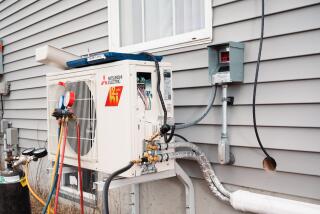Getting By With Less
- Share via
Achieving dramatic energy savings is something of a cinch when the builder starts from scratch and can custom-design an energy-efficient home or building. The Times has written in the past about the amazing energy savings of Amory Lovins’ home and work place in the Colorado Rockies. That may be fine for a visionary tinkerer like Lovins who could afford to build every sort of energy-saving wrinkle into a showcase home in the lofty solar-bright heights of the mountains.
But what about the average office building? Just how practical are these high-minded energy ideals there? Well, quite practical indeed, it seems. Consider the 10th, 11th and 12th floors of the 1920s-era Crystal Building at 40 W. 20th St. in New York City. This is the new home of the Natural Resources Defense Council and covers between 25,000 and 30,000 square feet of office space.
From the day the NRDC moved into its new quarters last week, the conservation organization began cutting its lighting costs by an estimated 75%. NRDC energy expert David Goldstein expects to achieve a 50% savings on the council’s total energy bill. The retrofit incorporates the most watt-stingy fluorescent light bulbs, solid state ballasts in the fluorescent fixtures, insulated double-pane windows that will capture heat in the winter and reflect it in the summer, and interior design that will create watts out of reflected light. Additional conservation will be achieved with computers that will calculate and set the ideal heating and cooling levels.
The cost of the conversion was about $500,000 more than conventional renovation. But Goldstein said NRDC will recoup that investment, including interest costs, in five to six years. After that, the ongoing energy savings are pure gravy. And none of the fixtures used needed to be designed for the NRDC project. Everything was purchased off the shelf and is available to any builder. As more developers buy such fixtures, the prices will come down. And employees are finding that the lighting is entirely adequate, meeting illumination standards set by industry groups, Goldstein said.
The implications of the NRDC project are potentially staggering. Commercial office space consumes about 100,000 megawatts of electrical power nationally, Goldstein said. Retrofitting to cut that energy consumption by half would save the equivalent output of 50 Diablo Canyon nuclear power plants. Common sense and market forces should be generating energy-efficient conversions at a rapid rate, but it is not happening. What does it take for the people who make such decisions to see the light?
More to Read
Inside the business of entertainment
The Wide Shot brings you news, analysis and insights on everything from streaming wars to production — and what it all means for the future.
You may occasionally receive promotional content from the Los Angeles Times.









